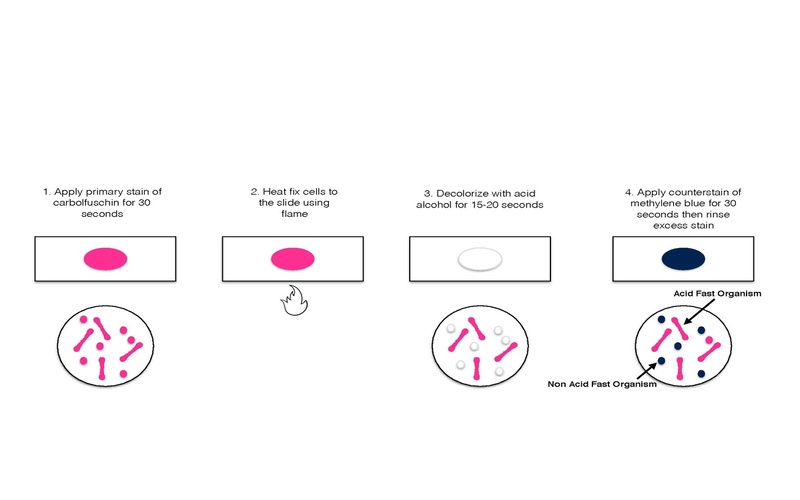What is Ziehl-Neelsen staining?
Table of Contents
hide
- The Ziehl-Neelsen stain is a differential staining method developed by Ziehl at first and then modified by Neelsen. So this method is also called Ziehl-Neelsen staining technique.
- Neelsen heated the carbol-fuschin from Ziehl’s experiment, added methylene blue dye as a counterstain, and utilized acid-alcohol as a decolorizing agent. Thus Ziehl-Neelsen staining technique was developed.
- For microorganisms that do not stain using the basic or Gram staining method, this method is used. In particular, the resistant members of the genus Mycobacterium can only be seen by the use of Ziehl-Neelsen staining.
- Actinomycetes, Mycobacterium, Isospora, Cryptosporidium, Norcadia, and certain fungi have thick cell walls composed of lipoidal compounds called mycolic acid.
- Because mycolic acid is difficult to stain, basic stains like gram staining are unable to penetrate the thick cell walls of these organisms.
- The use of Ziehl-Neelsen or the hot method of Acid-fast stain is necessary because they require stronger treatments to allow stain penetration for identification and testing.
Objectives of the Ziehl-Neelsen Staining
- To distinguish between acid-fast bacilli and non-acid-fast bacilli.
- To stain Mycobacterium species.
Principle of the Ziehl-Neelsen Staining
- The cell walls of Mycobacterium species are stained using the Ziehl-Neelsen stain, which uses basic phenol and fuchsin compounds.
- Because Mycobacterium is unable to bind readily to simple stains, visibility is made possible by passing heat through the bacterial cell wall in conjunction with carbol-fuschin and phenol.
- Mycobacterium cell walls are waxy, hydrophobic, and impermeable due to the high lipid content composed of mycolic acid.
- Carbol-fuschin is a basic that binds strongly to the negative components of bacteria, including their lipid cell wall and mycolic acid. When acid alcohol is added and heat is applied, a strong complex is formed that is difficult to remove with solvents.
- This method has been applied to the detection of Mycobacterium leprae and Mycobacterium tuberculosis.
Reagents used in the Ziehl-Neelsen Stain
- Primary stain: Carbol-fuchsin
- Decolorizer: Acid-Alcohol (20% sulfuric acid)
- Counter stain: Methylene blue/Malachite green
Preparation of reagents
Carbol-fuchsin
- Distilled water: 100ml
- Basic fuschin: 1g
- Ethyl alcohol (100% ethanol): 10ml
- Phenol crystals: 5ml
Acid alcohol (3% hydrochloric acid in 95% ethyl alcohol)
- Ethyl alcohol: 95 ml
- Distilled water: 2 ml
- Concentrated hydrochloric acid: 3 ml
0.25% methylene blue in 1% acetic acid
- Methylene blue- 0.25g
- Distilled water- 99ml
- Acetic acid- 1ml
Procedure of Ziehl-Neelsen Staining
- Take a clean and grease-free slide and label it.
- Prepare bacterial smear using a sterile technique.
- Dry the smear in air.
- Fix the smear by passing it over the flame.
- Flood the slide with carbol fuchsin. wash with tap water.
- Heat the slide with a spirit lamp until vapour rises (do not boil it), taking care that it doesn’t get dried (3-5 minutes).wash with tap water.
- Add a decolourizer of 20% sulfuric acid. wash with tap water.
- Add Methylene blue/Malachite green solution for 1 minute. wash with tap water.
- Dry the smear in air.
- Examine the smear under the oil immersion objective to look for acid-fast bacilli.

Image Source: Elizabeth Gray.
Results and Interpretation
Mycobacterium tuberculosis visualization using the Ziehl–Neelsen stain. Image Source: Wikipedia
- Acid-fast bacteria: Bright red to intensive purple
- Non-acid fast bacteria: Blue colour
Reporting system
- 0 AFB/100 field …………………No AFB seen
- 1-2 AFB/ 300 field……………….. Scanty
- 1-10 AFB/100 field………………1+
- 11-100AFB/100 field.……………2+
- 1-10 AFB/field…… ……………3+
- >10 AFB/field……………… ….4+
Applications of Ziehl-Neelsen Staining
- Used to examine and identify different species of Mycobacterium.
- Used to distinguish between acid-fast and non-acid-fast bacilli.
- Used to identify certain fungal species, such as Cryptosporidium.
Limitations of Ziehl-Neelsen Staining
- This method works only for acid-fast bacilli identification.
- The organism’s physical morphology is warped.
Read Also
References
- Ziehl-Neelsen Staining- Principle and Procedure with Results- Microbe Notes
- Acid-Fast Stain- Principle, Procedure, Interpretation and Examples- Microbiologyinfo.com
- Ziehl-Neelsen-AFB Staining: Microbe Online
- Ziehl-Neelsen Stain- Wikipedia
- Ziehl-Neelsen Stain- an overview